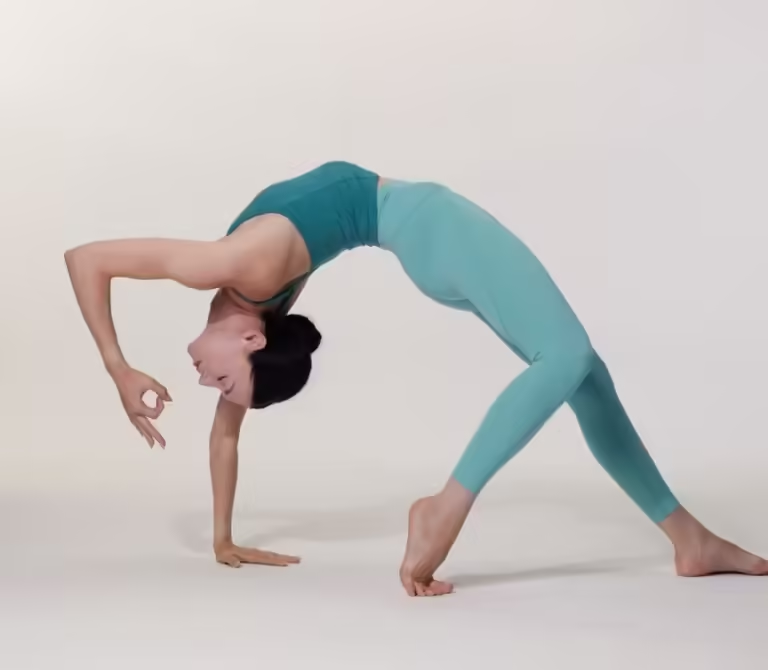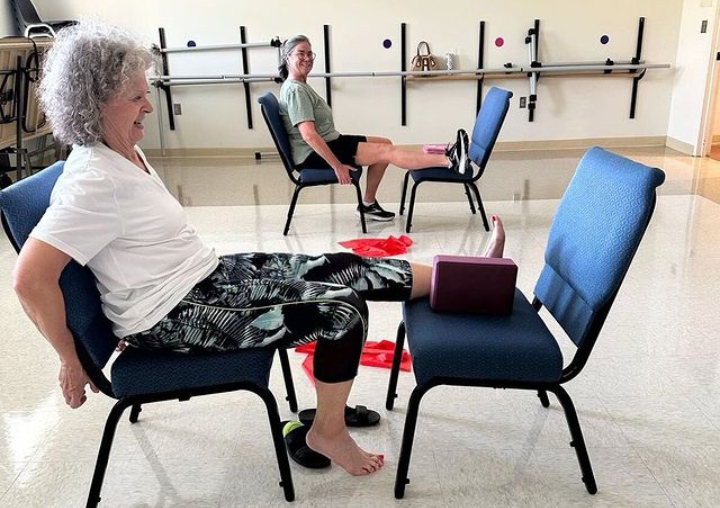Table of Contents
Somatic Yoga for Beginners

In the fast-paced world of today where physical discomfort, anxiety and stress are frequent somatic yoga has become a strong yet compassionate method of mind and body healing. This special style of yoga aims to improve the mind body connection, raise
Those who have lost mobility as a result of stress, accident, or bad posture will find that somatic yoga is very helpful since it provides attentive movement to relieve musculoskeletal pain. Somatic yoga is a therapeutic choice for healing and well-being, regardless of your level of experience.
Definition of somatic yoga, its advantages and some somatic yoga poses you can try out on a regular basis are all covered in this article.
What is Somatic Yoga?

Somatic yoga is a therapeutic yoga style that integrates the principles of somatic movement a bodywork approach that stresses conscious control over movement and internal bodily experience with classic yoga poses.
The word “somatic” originates from the Greek word “soma” signifying body or living body. Bringing awareness to the body, focusing on how it feels and slowly and mindfully exploring moves are the main goals of somatic yoga. Release of tension and restoration of mobility are the main objectives of somatic yoga and which is a gentler form of yoga than more strenuous forms like Vinyasa or Power Yoga.
Somatic Yoga Elements:
- Mindful Movement: Every pose is executed carefully, purposefully and fully aware of the pose. This aids practitioners in being more aware of tense and constrictive tendencies that they may have.
- Breath Awareness: In somatic yoga breathing is a key component. In order to reduce stress and enhance the body’s energy flow breathe deeply and in time with each action.
- Neuromuscular Reprogramming: By urging the brain to let go of accumulated muscle tension, somatic yoga helps retrain the neurological system resulting in better posture and movement patterns.
- Self-Awareness: Proprioception or the awareness of one’s own body position and movement in space is improved by somatic activities, which promote a sense of greater body awareness in practitioners.
Benefits of Somatic Yoga
Somatic yoga has numerous health benefits that encompass both mental and physical well being. The following are a few of the main benefits:
1. Pain Relief: By releasing tension in the muscles and fascia somatic yoga helps reduce chronic pain. For people who have joint discomfort, neck pain or back pain and it works very well.
2. Better Flexibility and Mobility: Somatic yoga can improve flexibility and mobility by promoting body awareness and releasing tense, chronic muscles and which can make daily movements more comfortable and fluid.
3. Decreased Stress and Anxiety: The technique promotes relaxation by turning on the body rest and digest system, the parasympathetic nerve system, which aids in the reduction of stress, anxiety and exhaustion.
4. Improved Posture: Repetitive motions or extended sitting can cause bad posture in many people. Through the introduction of more efficient movement and heightened awareness of habitual patterns somatic yoga assists in the correction of postural abnormalities.
5. Improved Mind-Body Connection: Somatic yoga helps to close the gap between the mind and the body shedding light on the physical manifestations of emotional and psychological stress as well as the ways in which conscious movement can aid in healing.
Somatic Yoga Poses
Here are the 10 Poses of Somatic Yoga: which you should try.
| Pose Number | Somatic Yoga Pose | Description |
|---|---|---|
| 1 | Somatic Cat-Cow Stretch | Gently mobilizes the spine releasing tension in the back. |
| 2 | Pelvic Tilts | Engages the core and lower back by tilting the pelvis slowly. |
| 3 | Shoulder Blade Slides | Loosens upper back tension through mindful shoulder movement. |
| 4 | Hip Circles | Improves hip mobility with slow, circular motions. |
| 5 | Somatic Bridge Pose | Strengthens glutes and lower back by lifting the hips. |
| 6 | Somatic Supine Twist | Stretches and relaxes the spine easing tension in the lower back. |
| 7 | Somatic Forward Fold | Lengthens the hamstrings and releases tension in the lower back. |
| 8 | Somatic Child’s Pose | Gently stretches the back and hips while promoting relaxation. |
| 9 | Somatic Warrior I | Strengthens legs and improves balance in a standing pose. |
| 10 | Somatic Reclined Butterfly | Opens the hips while lying down relieving tension and stress. |
Somatic Yoga Exercises for Daily Practice
If it feels nice in your body and you may want to close your eyes while performing the following somatic exercises. Shutting your eyes can assist you in turning your attention within minimizing outside disturbances and strengthening your bond with your body.
Pay attention to your inner experiences as you explore these somatic activities. We welcome your curious exploration of these inner experiences. Let the feelings in your body direct and influence your work. Finding what feels right in your body may mean that you have to modify the tempo skip some motions modify your breathing pattern or even back out of a position. All of these options are based on your body feedback. Recognize and value the wisdom of your body by listening to it.
Here are a few somatic yoga poses that you may do on a regular basis to increase mobility, relieve stress and enhance your general health. Every movement should be performed slowly, deliberately and in time with the breath, paying attention to bodily sensations.
Here are the 7 Somatic Yoga Exercises for Beginners
- Somatic Cat-Cow Stretch
A mild spinal movement called the Somatic Cat-Cow Stretch can help relieve tension in the shoulders, hips and lower back. Somatic movement enables you to explore your range of motion more slowly and methodically than the classic yoga Cat-Cow.
How to Perform:
- Start with putting your hands under your shoulders and your knees under your hips while on all fours.
- Taking a deep breath, slowly arch your back and raise your head and tailbone toward the ceiling, assuming the cow pose.
- Draw your tummy toward your spine and tuck your chin into your chest as you exhale and curve your spine (Cat Pose).
- Feel the feelings in your chest and spine as you slowly and fluidly transition between these two positions. Repeat 8–10 gentle cycles while coordinating your breathing.
2. Pelvic Tilts
One of the most basic somatic exercises is the pelvic tilt which targets the lower back and pelvis. Enhancing pelvic alignment and alleviating lower back discomfort are two benefits of this exercise.
How to Do It:
- Place your feet flat on the floor, hip-width apart and lie on your back with your knees bent.
- Take a breath and arch your lower back slightly by softly tilting your pelvis forward.
- Breathe out while bringing your pelvis back and pressing your lower back onto the ground.
- Go back and forth between these motions, taking your time and paying attention to how your lower back and pelvis feel. Do this ten to twelve times.
3. Shoulder Blade Slides
Many people carry stress in their shoulders and upper back which can be relieved with this exercise. Shoulder mobility and posture can be greatly enhanced with the use of shoulder blade slides.
How to Do It:
- With your hands facing downward, place your arms by your sides.
- Lay flat on your back with your feet flat on the ground and your knees bent.
- As you inhale, slowly move your shoulder blades up toward your ears.
- Breathe out as you feel your shoulder blades move away from your ears as you slide them down your back.
- Move your shoulder blades while concentrating on the sensations in your upper back.
Do eight to ten repetitions.
4. Somatic Hip Circles
Somatic Hip Circles relieve stress in the lower body by enhancing hip and pelvic mobility. For people who have tight hips or spend a lot of time sitting down this exercise is excellent.
How to Do It:
- Put your hands on your hips while standing with your feet hip-width apart.
- Start slowly rotating your hips clockwise adjusting the size of the circles to suit your comfort level.
- Change to rotating counterclockwise after a few turns.
- As you move pay attention to how your hips and lower back feel.
- 8–10 reps in each direction should be repeated.
5. Somatic Neck Release
Neck release exercise relieves shoulder and neck strain which is frequently brought on by stress and bad posture.
How to Do It:
- Take a seat comfortably, either on the floor or in a chair with your back straight.
- With your right ear close to your right shoulder, gently cock your head to the right.
- Feel the stretch along the left side of your neck while you hold for a few breaths.
- Return to center slowly then shift your head to the left and bring your left ear close to your left shoulder.
- While you move gently and mindfully, concentrate on the feelings in your shoulders and neck.
On each side repeat three to five times.
6. Somatic Shoulder Rolls
The shoulder roll is a fantastic supplementary exercise that helps to reduce upper body stress and improve shoulder mobility.
Method for doing it:
- With your arms by your sides take a comfortable seat or stand.
- As mindfully and gently as possible begin by slowly rotating your shoulders forward in a circle.
- After a few rolls in the opposite direction and roll your shoulders back.
- Take note of how your shoulders and upper back are feeling.
- In each direction repeat eight to 10 times
7. Somatic Leg Slides
The goal of leg slides is to increase lower body and leg range of motion while relieving tension in the hips. Additionally beneficial for improving coordination is this movement.
How to Perform It:
- Lay flat on your back with your feet flat on the ground and your knees bent.
- One leg should be slowly extended straight out while maintaining contact with the floor.
- After a brief period of time spent in full extension carefully return the leg to its beginning position.
- Continue slowly and deliberately while moving on the opposite side.
- Do 8–10 reps on each side and then stop.
Somatic Yoga for Weight Loss
The goal of somatic yoga for weight loss is to release chronic tension and enhance body awareness through gentle, thoughtful movements that can also help with mobility, posture and general well-being. Somatic yoga helps lower stress, which is linked to weight gain, and promotes healthy movement patterns by retraining the nerve system and strengthening the mind-body connection. Somatic yoga helps people lose weight even if it is not a strenuous exercise because it improves flexibility, eases tension and corrects muscular imbalances that could prevent exercise. This all-encompassing method feeds the body and the mind, which makes it a healthy and long-lasting addition to other weight loss techniques.
FAQs
How does somatic yoga differ from traditional yoga?
Somatic yoga focuses more emphasis on interior sensations and awareness whereas traditional yoga frequently stresses postures (asanas), alignment and exterior techniques. It helps people explore and release tension, enhance body awareness and cultivate a closer connection to their own physical experience through the use of deliberate, slow movements.
How does somatic yoga address body tension and pain?
Somatic yoga approaches use attentive movement and breathwork to explore and release tension retained in the body. Practitioners may frequently locate and treat the causes of pain or discomfort by increasing their awareness of physiological feelings and patterns.
Can somatic yoga be combined with other forms of exercise or therapy?
Yes, somatic yoga can be used in conjunction with other therapeutic practices and various types of exercise including traditional yoga, strength training and cardio. It can be a beneficial supplement to a wholistic strategy for mental and physical well-being.
For fitness blogs click here.

Ankush Kumar is a professional content writer and the founder of Healthnick.com. He is a health and wellness enthusiast with a deep interest in nutrition, fitness and holistic living. Harish is committed to delivering research-based insights on various health topics. He enjoys exploring new trends in health, experimenting with nutritious recipes, and staying active.






